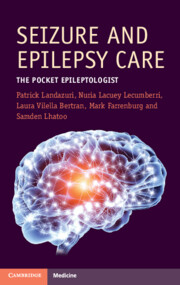Book contents
- Seizure and Epilepsy Care
- Seizure and Epilepsy Care
- Copyright page
- Contents
- 1 How Do I Evaluate a First-Time Seizure?
- 2 How Do I Make an Epilepsy Diagnosis?
- 3 Which Antiseizure Medicines Treat Epilepsy and How Do I Pick?
- 4 How Can I Best Use EEG for Treating Epilepsy Patients?
- 5 What Are Common Epilepsy Imaging Findings in New Onset and Chronic Epilepsy Care?
- 6 How Do I Care for Patients in the Emergency Department and Inpatient Settings?
- 7 How Do I Manage Epilepsy Emergencies Like Status Epilepticus?
- 8 What Is the Best Long-Term Treatment Plan for Epilepsy Patients as an Outpatient?
- 9 What to Do When Your Patient Fails Two Antiseizure Medicines
- 10 Nonepileptic Events and General Psychiatric Care for Epilepsy Patients
- 11 What Are Essential Pediatric Epilepsy Clinical Diagnoses and Treatment Plans?
- Index
- References
9 - What to Do When Your Patient Fails Two Antiseizure Medicines
Managing Drug-Resistant Epilepsy as an Outpatient
Published online by Cambridge University Press: 28 January 2023
- Seizure and Epilepsy Care
- Seizure and Epilepsy Care
- Copyright page
- Contents
- 1 How Do I Evaluate a First-Time Seizure?
- 2 How Do I Make an Epilepsy Diagnosis?
- 3 Which Antiseizure Medicines Treat Epilepsy and How Do I Pick?
- 4 How Can I Best Use EEG for Treating Epilepsy Patients?
- 5 What Are Common Epilepsy Imaging Findings in New Onset and Chronic Epilepsy Care?
- 6 How Do I Care for Patients in the Emergency Department and Inpatient Settings?
- 7 How Do I Manage Epilepsy Emergencies Like Status Epilepticus?
- 8 What Is the Best Long-Term Treatment Plan for Epilepsy Patients as an Outpatient?
- 9 What to Do When Your Patient Fails Two Antiseizure Medicines
- 10 Nonepileptic Events and General Psychiatric Care for Epilepsy Patients
- 11 What Are Essential Pediatric Epilepsy Clinical Diagnoses and Treatment Plans?
- Index
- References
Summary
Around a third of patients have drug-resistant epilepsy (DRE). This is crucially and easily determined if a patient continues to have seizures after being on two adequately dosed and appropriately selected antiseizure medicines (ASMs). For these patients, your initial efforts to make a specific and localized diagnosis will inform next treatment decisions. If a patient presents suddenly with DRE, it is key to assess for a possible autoimmune cause, as a separate treatment pathway should be considered. Otherwise, consider epilepsy surgery as an effective treatment. These treatments include brain resections and neuromodulation. Minimally invasive techniques have recently become more common, including laser surgery as well as stereotactically placed depth electrodes. Given the prevalence of neurostimulators, consideration for obtaining MRIs in patients with these devices is addressed, as pathways exist for all of these patients to safely undergo MRI testing.
- Type
- Chapter
- Information
- Seizure and Epilepsy CareThe Pocket Epileptologist, pp. 156 - 174Publisher: Cambridge University PressPrint publication year: 2023

